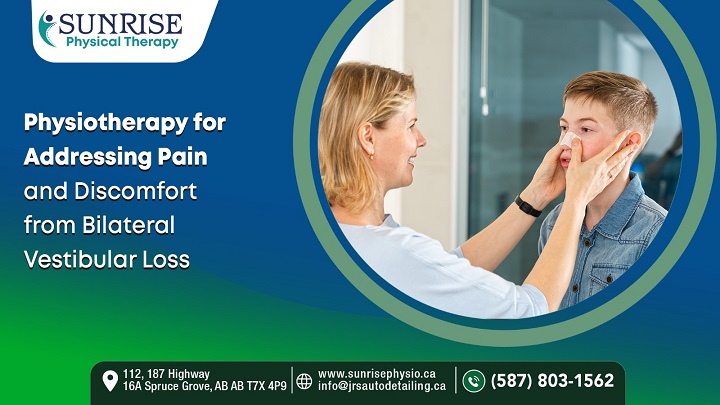Bilateral Vestibular Loss (BVL) is the partial or complete loss of function in both vestibular organs in the inner ear. These organs are crucial in maintaining balance, spatial orientation, and coordination. When both vestibular systems are impaired, individuals often experience significant challenges, including pain and discomfort. Fortunately, vestibular physiotherapy Spruce Grove can offer effective strategies to address these symptoms and help patients regain stability and quality of life.
Causes And Symptoms of Bilateral Vestibular Loss
Bilateral Vestibular Loss (BVL) can be caused by factors such as ototoxic medications, meningitis, head trauma, and age-related degeneration, leading to a range of symptoms. These include persistent dizziness, oscillopsia (blurred vision during movement), imbalance, occasional vertigo, nausea, and difficulty walking in low-light conditions. These symptoms can affect daily activities.
How Physiotherapy Can Help with Bilateral Vestibular Loss
Vestibular physiotherapy in Spruce Grove plays a vital role in managing the symptoms of Bilateral Vestibular Loss. Through targeted exercises and interventions, physiotherapists can help patients adapt to their condition, improve balance, and reduce discomfort. The following are essential physiotherapy techniques used to address BVL:
Vestibular Rehabilitation Therapy (VRT)
Vestibular Rehabilitation Therapy (VRT) is the cornerstone of physiotherapy for Bilateral Vestibular Loss. This vestibular rehab therapy involves exercises designed to help the brain adapt to the loss of vestibular function by relying more on other senses, such as vision and proprioception (the sense of body position).
- Gaze stabilization exercises are crucial for managing Bilateral Vestibular Loss (BVL) as they enhance visual focus and stability during head movements. For instance, patients try to fix their gaze on a stationary object while moving their head from side to side or up and down. The goal is to maintain a clear image of the object despite the head movement. Physiotherapists recommend these exercises daily to help patients adapt visually and improve stability.
- Balance training exercises are crucial in managing the instability linked with Bilateral Vestibular Loss (BVL). For instance, tandem walking—where the patient walks in a straight line with one foot directly in front of the other—helps to enhance muscle strength and improve coordination. Performing these exercises on different surfaces or with eyes closed can further challenge and enhance the balance system. Regular practices help to reduce the risk of falls and improve overall stability and balance.
- Habituation exercises are also crucial for managing BVL, as they help reduce the brain’s sensitivity to dizziness-inducing stimuli. Patients might perform repeated head turns or sit-to-stand movements that initially provoke dizziness. Over time, with supervised practice, the brain learns to better compensate for these abnormal signals. Physiotherapists adjust these exercises as the patient’s tolerance improves, contributing to reduced dizziness and enhanced functional ability.
Gait Training
Gait training is another essential component of physiotherapy for Bilateral Vestibular Loss. BVL can significantly affect a person’s walking ability, especially in challenging environments. Physiotherapists work with patients to retrain their walking patterns, improve coordination, and build confidence.
- Treadmill training with visual cues is an effective strategy for managing Bilateral Vestibular Loss (BVL). During this exercise, patients walk on a treadmill while focusing on visual cues, such as moving images or patterns. It helps them improve their gait and adapt to the loss of vestibular input by synchronizing their movements and enhancing gait stability. Try to incorporate it in regular physiotherapy sessions, with the intensity and complexity adjusted based on the patient’s progress.
- Obstacle course navigation is another valuable technique for patients with BVL. By navigating a course with various challenges, such as stepping over cones, walking on different surfaces, or maneuvering around obstacles, patients can develop better spatial awareness and adapt to real-world conditions. Physiotherapists adjust the difficulty of the obstacle course as the patient’s abilities improve, ensuring ongoing progress and adaptation.
Exercise Therapy
Strengthening exercises are crucial for patients with Bilateral Vestibular Loss, as muscle weakness can exacerbate balance issues—physiotherapists design programs to enhance core strength, lower body strength, and overall endurance.
- For patients with Bilateral Vestibular Loss (BVL), core stability exercises are crucial for building strength in the abdominals, back, and pelvic muscles. It is essential for preventing falls. Performing planks by beginning with 20-30 seconds and gradually increasing the duration helps to improve the strength.
- Leg strengthening exercises are vital for patients managing Bilateral Vestibular Loss (BVL), as they build the leg muscles needed for balance and stability. Performing squats several times weekly, adjusting the intensity and difficulty based on their progress and ability, enhances leg strength and supports overall stability.
These programs are typically performed daily or as recommended, with regular follow-ups to track progress and make necessary adjustments.
Regain Balance and Confidence with Physiotherapy for Bilateral Vestibular Loss
Living with Bilateral Vestibular Loss can present significant challenges, but effective vestibular physiotherapy in Spruce Grove can help manage and overcome many of these difficulties. Sunrise Physical Therapy Clinic’s experienced team is committed to delivering tailored techniques to each patient’s unique needs. Patients can regain balance, reduce discomfort, and enhance overall well-being through targeted vestibular physiotherapy.
Individuals are encouraged to contact Sunrise Physical Therapy to start the journey toward improved balance and comfort.
Read More: Physiotherapy for Addressing

